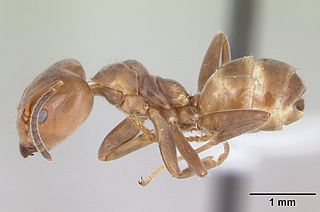
Ants are eusocial insects of the family Formicidae and, along with the related wasps and bees, belong to the order Hymenoptera. Ants evolved from vespoid wasp ancestors in the Cretaceous period. More than 13,800 of an estimated total of 22,000 species have been classified. They are easily identified by their geniculate (elbowed) antennae and the distinctive node-like structure that forms their slender waists.

Leafcutter ants, a non-generic name, are any of 47 species of leaf-chewing ants belonging to the two genera Atta and Acromyrmex. These species of tropical, fungus-growing ants are all endemic to South and Central America, Mexico, and parts of the southern United States. Leafcutter ants can carry twenty times their body weight and cut and process fresh vegetation to serve as the nutritional substrate for their fungal cultivates.

Fire ants are several species of ants in the genus Solenopsis, which includes over 200 species. Solenopsis are stinging ants, and most of their common names reflect this, for example, ginger ants and tropical fire ants. Many of the names shared by this genus are often used interchangeably to refer to other species of ant, such as the term red ant, mostly because of their similar coloration despite not being in the genus Solenopsis. Both Myrmica rubra and Pogonomyrmex barbatus are common examples of non-Solenopsis ants being termed red ants.

Lycaenidae is the second-largest family of butterflies, with over 6,000 species worldwide, whose members are also called gossamer-winged butterflies. They constitute about 30% of the known butterfly species.

Myrmicinae is a subfamily of ants, with about 140 extant genera; their distribution is cosmopolitan. The pupae lack cocoons. Some species retain a functional sting. The petioles of Myrmicinae consist of two nodes. The nests are permanent and in soil, rotting wood, under stones, or in trees.

Carpenter ants are large ants indigenous to many forested parts of the world.

The name army ant (or legionary ant or marabunta) is applied to over 200 ant species in different lineages. Because of their aggressive predatory foraging groups, known as "raids", a huge number of ants forage simultaneously over a limited area.
Sciotropis is a genus of flatwings in the damselfly order Odonata. There are at least two described species in Sciotropis.

Pachycondyla is a ponerine genus of ants found in the Neotropics.

Lachnomyrmex amazonicus is a species of ant in the subfamily Myrmicinae.

Lachnomyrmex fernandezi is a species of ant in the subfamily Myrmicinae.

Lachnomyrmex laticeps is a species of ant in the subfamily Myrmicinae.

Lachnomyrmex longinoi is a species of ant in the subfamily Myrmicinae found in Honduras, Nicaragua, Costa Rica.

Lachnomyrmex mackayi is a species of ant in the subfamily Myrmicinae.

Lachnomyrmex nordestinus is a species of ant in the subfamily Myrmicinae.

Lachnomyrmex regularis is a species of ant in the subfamily Myrmicinae.

Lachnomyrmex victori is a species of ant in the subfamily Myrmicinae.

Azteca is a strictly Neotropical genus of ants in the subfamily Dolichoderinae. The genus is very diverse and contains around 84 extant species and two fossil species. They are essentially arboreal and many species have mutualistic associations with particular plant species, where the genus Cecropia presents the most conspicuous association. In the Brazilian Amazonia, Azteca species are associated with species of Codonanthopsis.

Acanthostichus is a predatory and predominantly subterranean genus of ant in the subfamily Dorylinae. They are found in the New World, from the southern United States to Uruguay, Paraguay and northern Argentina. They are probably common, but due to their subterranean nature, they are seldom collected or seen.

Lachnomyrmex is a Neotropical genus of ants in the subfamily Myrmicinae. The genus consists of 16 species restricted to the Neotropics, known from southern Mexico to northern Argentina. They are most often found in the leaf litter of wet forests, with nests located on the ground. Workers forage alone, apparently without recruiting nestmates or using pheromones. Within the tribe Stenammini, they seem to be most closely related to the genera Lordomyrma of Indo-Australia and Cyphoidris of Africa.


















